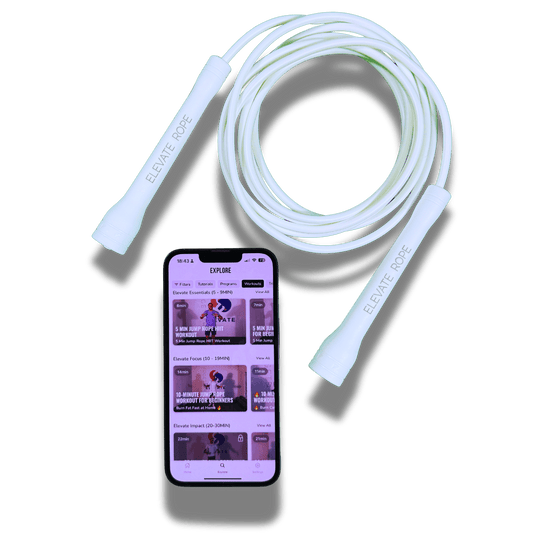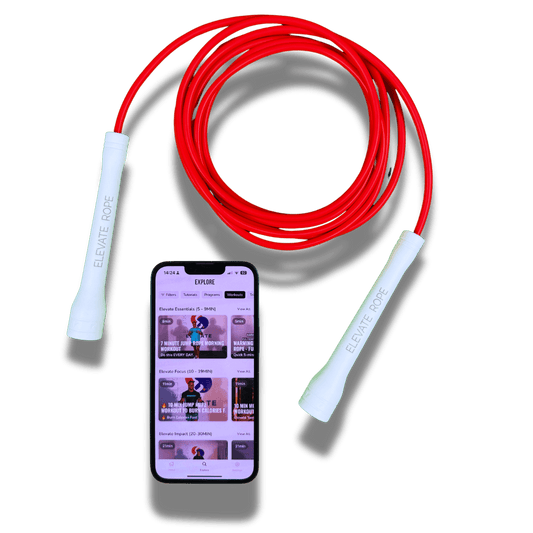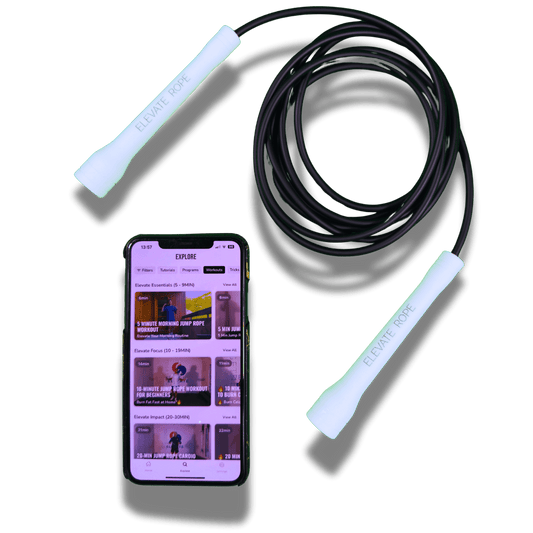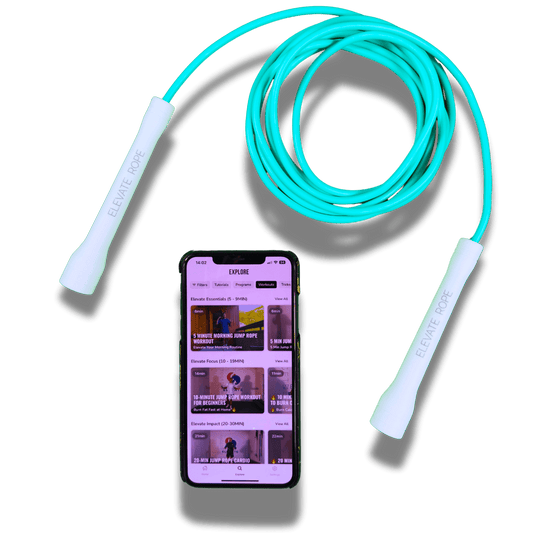Het Spiegel Effect
Zelfvertrouwen bij touwtjespringen komt niet uit de spiegel. Het komt uit beweging. Uit elke draai, sprong en struikel die je eraan herinnert — je bent er. Op een gegeven moment verloor fitness zijn ziel. Het werd straf. Een race om esthetiek. Een vergelijkingsspel. Maar het touw? Het brengt de vreugde terug.
Elke sprong verbindt je opnieuw met je lichaam. Niet als iets om te repareren, maar als iets om te voelen. Je hoort het geluid van het touw. Je voelt je hartslag stijgen. Dat ritme? Dat is kracht. Het is je herinnering dat kracht niet wordt gemeten in spiegels — het wordt opgebouwd in momenten.
Er is geen machine die je vertelt wat je moet doen. Niemand die je vorm beoordeelt. Alleen jij, de vloer, en een ritme dat alleen van jou is. Elke nieuwe truc, elke soepele landing, elke seconde langer — het telt allemaal. Kleine overwinningen die zich opstapelen tot geloof.
Langzaam begin je jezelf anders te zien. Niet omdat je reflectie veranderde. Maar omdat je relatie met beweging dat deed. Zelfvertrouwen stopt met een beeld te zijn — het wordt energie. Iets wat je met je meedraagt lang nadat de sessie is afgelopen.
Want echt vertrouwen begint niet met hoe je eruitziet. Het begint met hoe je beweegt. En één touw kan alles veranderen.

De verschuiving: hoe springtouwvertrouwen beweging omzet in empowerment
Voor veel mensen begint fitness vanuit schuldgevoel — proberen goed te maken voor gemiste trainingen, overdadige weekenden, of een beeld in de spiegel waar ze niet helemaal van houden. Maar springtouwvertrouwen draait dat om. Het gaat niet om wat je lichaam niet is — het gaat om wat je lichaam kan doen als je begint te bewegen met een doel.
Er is iets transformerends aan het oppakken van een touw. Elke sprong is een kleine daad van rebellie tegen het giftige idee dat fitness pijn moet doen om effectief te zijn. Je straft jezelf niet langer in vorm; je bent jezelf aan het trainen naar vreugde. En met elke draai begin je zelfvertrouwen op te bouwen — dat stille, onwankelbare geloof dat je voorbij de grenzen kunt gaan die je ooit geloofde.
In de Elevate-gemeenschap gebeurt deze mindsetverschuiving dagelijks. Een beginner plaatst zijn eerste kruis; een ander viert 30 seconden onafgebroken springen. De reacties stromen binnen met vuur-emoji's, applaus en gejuich. Het is het bewijs dat empowerment niet komt door vergelijking — maar door verbinding.
En zodra die vonk overslaat, creëert het wat wij noemen De Vertrouwenslus: hoe meer vooruitgang je ziet, hoe meer je wilt blijven komen. Niet om je waarde te bewijzen — maar om die te eren.
Bewegingspsychologie: Waarom touwtraining het zelfbeeld versterkt
Springtouwvertrouwen is meer dan een mindset — het is een neurologische reactie op vooruitgang, ritme en flow. Wanneer je een touw oppakt, train je niet alleen spieren; je traint je brein om inspanning te associëren met prestatie. Elke draai geeft directe feedback — succes, ritme, of een snelle reset — en leert je geest zich aan te passen, te focussen en sneller te herstellen dan in bijna elke andere sport.
Psychologen omschrijven dit als micro mastery: de boost die komt van kleine, consistente overwinningen. Je eerste kruislanding maken, leren langer springen zonder te struikelen, of dat perfecte ritme raken — elke overwinning geeft een dopamineboost, het ingebouwde beloningssignaal van je brein. Dat is de chemie achter springtouwvertrouwen: elke sprong herbedraad letterlijk je brein om groei te verlangen in plaats van perfectie.
En dan is er ritme — het geheime ingrediënt. Het constante tempo van touwtraining activeert wat neurowetenschappers entrainment noemen: je brein dat synchroon loopt met repetitieve beweging. Het vermindert angst, verscherpt de focus en creëert die meditatieve "flow state" die zoveel springers beschrijven. Je stopt met nadenken over hoe je eruitziet en begint te voelen hoe krachtig je bent geworden.
🎥 Bekijk het gebeuren: Ik Had Nooit Verwacht Dat Touwtje Springen Mij Zo Zou Veranderen…
Die ritmische herhaling bouwt niet alleen coördinatie op — het bouwt geloof op. Elke sprong versterkt het idee dat vooruitgang wordt verdiend door aanwezigheid, en dat is de essentie van vertrouwen in touwtje springen: bewegen, leren en evolueren, één sprong tegelijk.
De Rol van de Gemeenschap: Jezelf Zien Door de Ogen van Anderen
Vertrouwen in touwtje springen groeit niet in isolatie — het bloeit op in verbinding. Je begint misschien met springen om je conditie te verbeteren, maar het is de gemeenschap om je heen die dat vertrouwen helpt wortelen en bloeien. Wanneer je je vooruitgang deelt, feedback ontvangt en anderen aanmoedigt, begin je jezelf te zien door een meer medelevende lens — een die inspanning boven perfectie waardeert.
Binnen de Elevate-gemeenschap gebeurt die transformatie elke dag. Een beginner viert 20 onafgebroken sprongen, en meteen vullen de reacties zich met energie, steun en emoji's. Een andere springer beheerst zijn eerste double under, en de hele feed licht op van feestvreugde. Die gedeelde opwinding is aanstekelijk. Je realiseert je dat vertrouwen geen solo-act is — het is een ritme dat zich vermenigvuldigt wanneer mensen samen bewegen.
Zelfs onderzoek ondersteunt dit: beweging die wordt beoefend binnen een positieve groepsomgeving verbetert het lichaamsbeeld en het zelfvertrouwen aanzienlijk.
👉 Lees meer in dit Psychology Today-artikel over hoe sportgemeenschappen het zelfbeeld verbeteren.
Wanneer je jezelf omringt met mensen die inspanning vieren, niet esthetiek, stopt het vertrouwen in touwtje springen met alleen over het touw te gaan — het wordt een manier om jezelf te zien. Door aanmoediging, verantwoordelijkheid en gedeelde overwinningen begin je te geloven wat anderen al in jou zien: iemand die capabel, sterk en in beweging is.
Vertrouwen Opbouwen Buiten het Touw
Het vertrouwen dat je opbouwt door touwtje te springen blijft niet alleen bij de training — het draagt door in je hele leven. Het zit in de manier waarop je voor jezelf opkomt, zelfs als niemand kijkt. Het zit in hoe je begint te geloven dat je tot meer in staat bent, één kleine overwinning tegelijk.
Elke sprong leert iets diepers dan coördinatie. Het leert consistentie, veerkracht en vertrouwen. Hetzelfde ritme dat je touw in beweging houdt, kan je mindset stabiel houden — door stress, twijfel of welke uitdagingen er ook op je pad komen. Je leert dat echte kracht niet gaat om perfectie; het gaat om aanwezigheid. Om op te dagen, zelfs als je je niet klaar voelt, en toch te bewegen.
Vertrouwen dat door beweging wordt opgebouwd, verandert in moed in alles wat je doet — op het werk, in relaties, in je doelen. En dat is het mooie ervan: één simpele gewoonte wordt de basis voor een sterkere, meer gegronde versie van jezelf.

Wanneer je begint te geloven in je eigen ritme, besef je dat vertrouwen niet iets is wat je vindt — het is iets wat je opbouwt, één sprong tegelijk.














